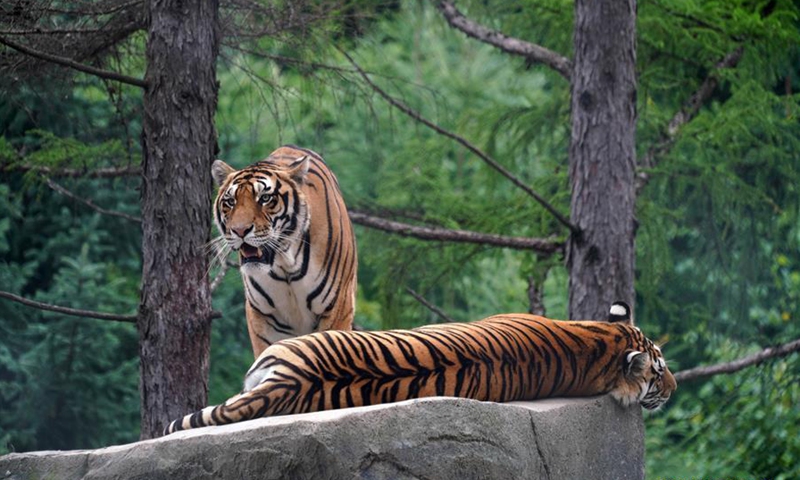
Siberian tigers rest at a free-ranging area of the Hengdaohezi Siberian Tiger Park in Hailin, northeast China's Heilongjiang Province, July 29, 2020. (Xinhua/Wang Jianwei)
The number of wild Siberian tigers and Amur leopards in a national park in Northeast China's Jilin and Heilongjiang provinces has climbed to 50 and 60, respectively, in just four years, shattering predictions that both species would become extinct in China.
Wildlife conservation experts noted that the national park, an internationally recognized approach, will become the main model for wildlife conservation in China, and co-managed national parks with other countries will be a direction to explore.
In 2017, the pilot system of the Northeast Tiger and Leopard National Park was officially launched in a bid to expand the populations of these two rare animals in China.
Recent data showed that during the pilot period, the forest stock increased by 5.2 percent, more than 10 new Siberian tiger cubs and more than seven Amur leopard cubs were bred, and the survival rate of cubs increased from about 30 percent to 50 percent, the Xinhua News Agency reported.
Frequent signs of activity of Siberian tigers and Amur leopards monitored in the field in this pilot area in recent years have indicated the positive effect on wildlife conservation, Sun Quanhui, a scientist from World Animal Protection, told the Global Times on Sunday.
Other good news has also come from time to time from the park. The brown bear, plum deer and many other rare and endangered species have shown population growth. The rare yellow-throated mink, which has variable fur colors, and rare white roe deer have also appeared in the park area, reflecting the achievements of ecological protection.
From August 2017 to August 2020, 188 wild animals were rescued in the park, including 69 under national protection, the China Central Television (CCTV) reported on Sunday.
The Northeast China Tiger and Leopard National Park was among the first
five national parks to be formally established on October 12 during the 15th meeting of the Conference of the Parties to the Convention on Biological Diversity.
Sun said that the establishment of national parks provides a proven conservation and management model that can reasonably handle the relationship between ecological protection and resource development and utilization, and it will become a main method in China's wildlife conservation.
"Practice shows that national parks not only help promote the environment and protect biodiversity, but they also help drive local tourism and economic and social development," Sun said. "It is an environmental protection method more recognized by the international community and a key area for China to work on in the future."
Sun also noted that cooperation between China and Russia will be very important in the conservation of Siberian tigers and Amur leopards, as observers point out that a multinational co-managed national park is likely to be a direction to explore.
A three-year cooperation action plan was officially signed in 2019 between China's Northeast Tiger and Leopard National Park and Russia's Land of the Leopard National Park.
The two parks vowed to share information resources and databases on scientific research, ecological monitoring, environmental education and ecological experience involving Siberian tigers and Amur leopards, effectively protecting these rare species, further improving the quality of the environment in the border region, and maintaining regional ecological balance and sustainable development.




